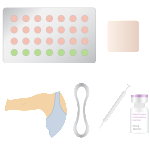 What are hormonal methods of birth control?
What are hormonal methods of birth control?
Hormonal methods of birth control are types of birth control that use hormones (estrogen and/or progestin) to help prevent ovulation. There are many different types of hormonal birth control, and they vary in their effectiveness.
What are the different types of female hormonal methods?
There are six types of female hormonal methods:
How does each method work, and how effective are they at preventing pregnancy?
Each female hormonal method has a different efficacy rate towards preventing pregnancy. These rates vary depending on “typical use” (how people usually use it or if it’s not used every time you have sex) vs. “perfect use” (when it’s used perfectly, every time you have sex). Keep in mind that perfect use hardly ever happens.
Hormonal Implants:
A hormonal implant is a tiny rod the size of a matchstick that gets inserted under the skin of a woman’s upper arm. The implant releases hormones that prevent pregnancy.
| Out of 100 women using hormonal implants | |
| Typical use: 1 or less women become pregnant in a year |  |
| Perfect use: 1 or less women become pregnant in a year |  |
Hormonal Intra-Uterine Devices (IUDs)
An IUD is a small device that is placed inside of a female’s uterus. The hormonal IUD releases hormones that prevent pregnancy and can stay in a woman’s body for up to five years.
| Out of 100 women using hormonal IUDs | |
| Typical use: 1 or less women become pregnant in a year |  |
| Perfect use: 1 or less women become pregnant in a year |  |
Birth Control Pills
Birth control pills (also called oral contraceptive pills or the “Pill”) are small tablets that a woman takes each day. The pills are made up of hormones (progestin-only or a combination of estrogen and progestin) that work to prevent pregnancy.
| Out of 100 women using combination or progestin-only pills | |
| Typical use: 9 women become pregnant in a year |          |
| Perfect use: 1 or less women become pregnant in a year |  |
Depo-Provera® Hormonal Injections:
Depo-Provera® is an injection (shot) that a woman is given every 3 months. The shot contains a hormone that works to prevent pregnancy.
| Out of 100 women using Depo-Provera® | |
| Typical use: 6 women become pregnant in a year |       |
| Perfect use: 1 or less women become pregnant in a year |  |
Estrogen/Progestin Hormonal Injections:
An estrogen-progestin hormonal injection is a shot than a woman receives once a month. It contains hormones that prevent pregnancy. Note: These injections are not available in the US.
| Out of 100 women using estrogen/progestin injections | |
| Typical use: 6 or less women become pregnant in a year |       |
| Perfect use: 1 or less women become pregnant in a year |  |
[/table-wrap]
Hormone Patch (Ortho-Evra®/Xulane®):
The hormone patch looks like a small square Band-Aid® and is worn on the skin; either on the stomach, buttocks, upper back, or upper arm. It contains hormones that get absorbed through the skin and works to prevent pregnancy.
| Out of 100 women using a hormone patch | |
| Typical use: 9 women become pregnant in a year |          |
| Perfect use: 1 or less women become pregnant in a year |  |
Vaginal Hormonal Ring (NuvaRing®):
The vaginal hormonal ring, or “ring” for short, is a small, flexible ring that a woman inserts into her vagina. The ring releases hormones that prevent pregnancy.
| Out of 100 women using a vaginal hormonal ring | |
| Typical use: 9 women become pregnant in a year |          |
| Perfect use: 1 or less women become pregnant in a year |  |
Do hormonal methods of birth control protect against STIs?
No. Hormonal methods of birth control do NOT protect against STIs.
Source: Read Full Article
